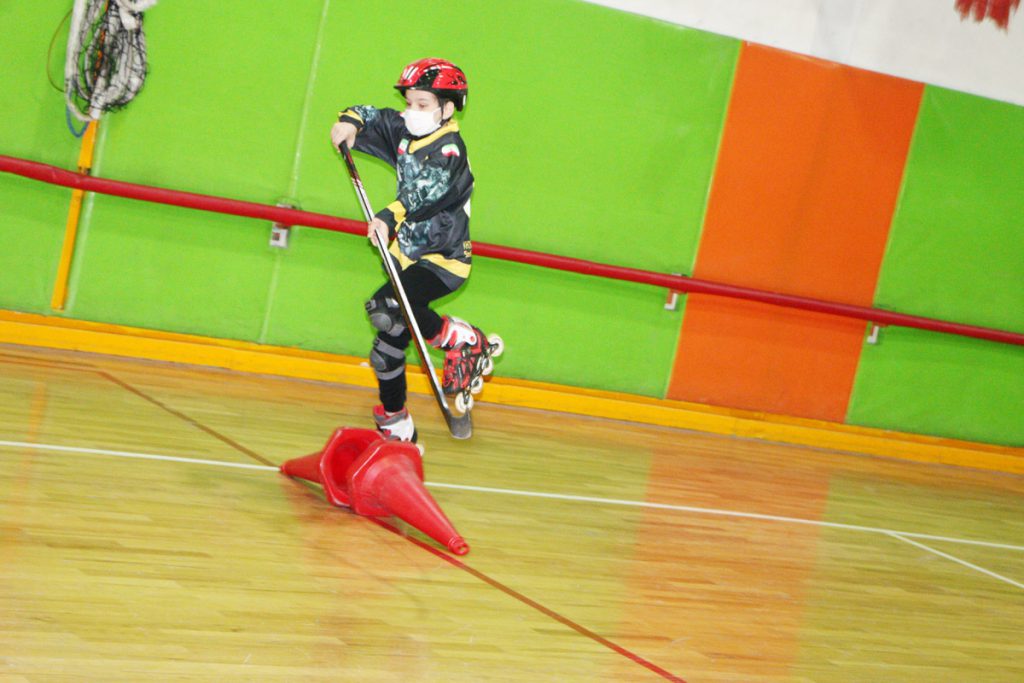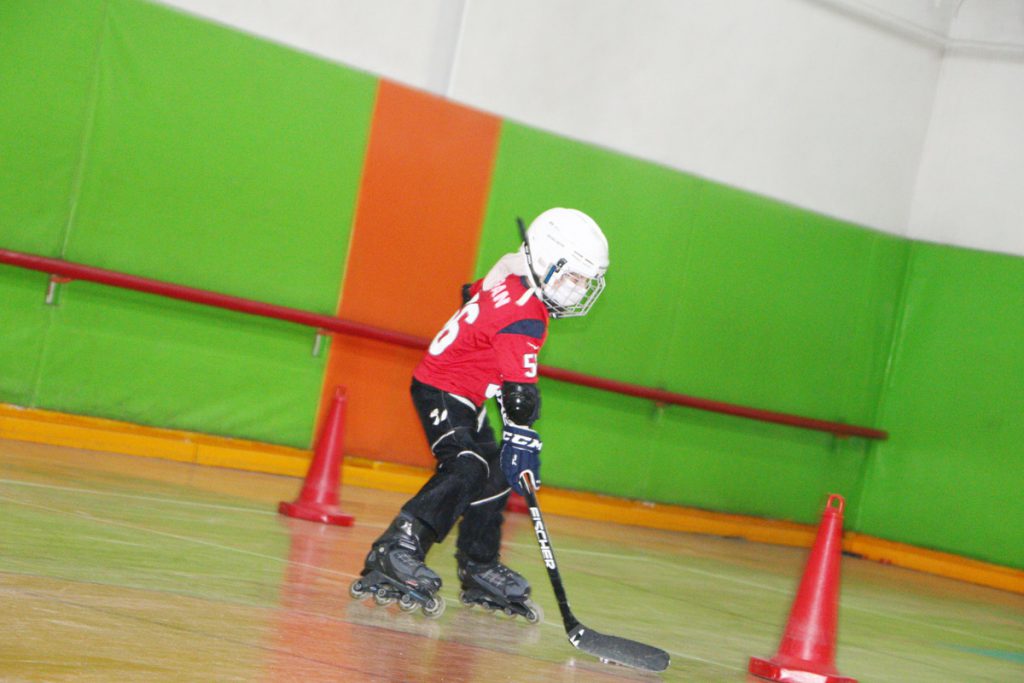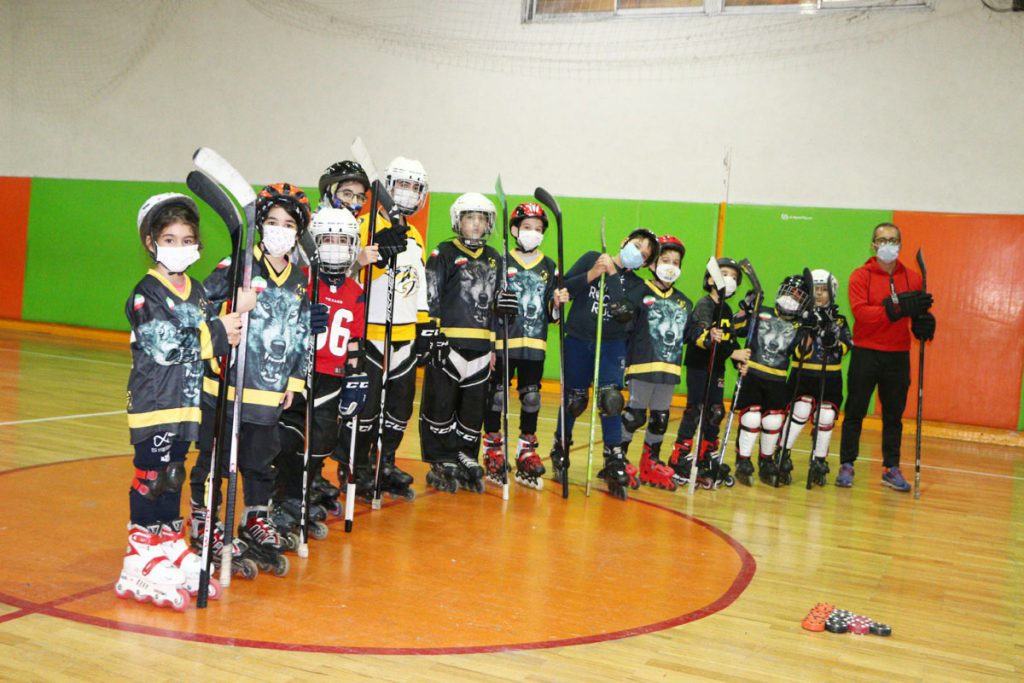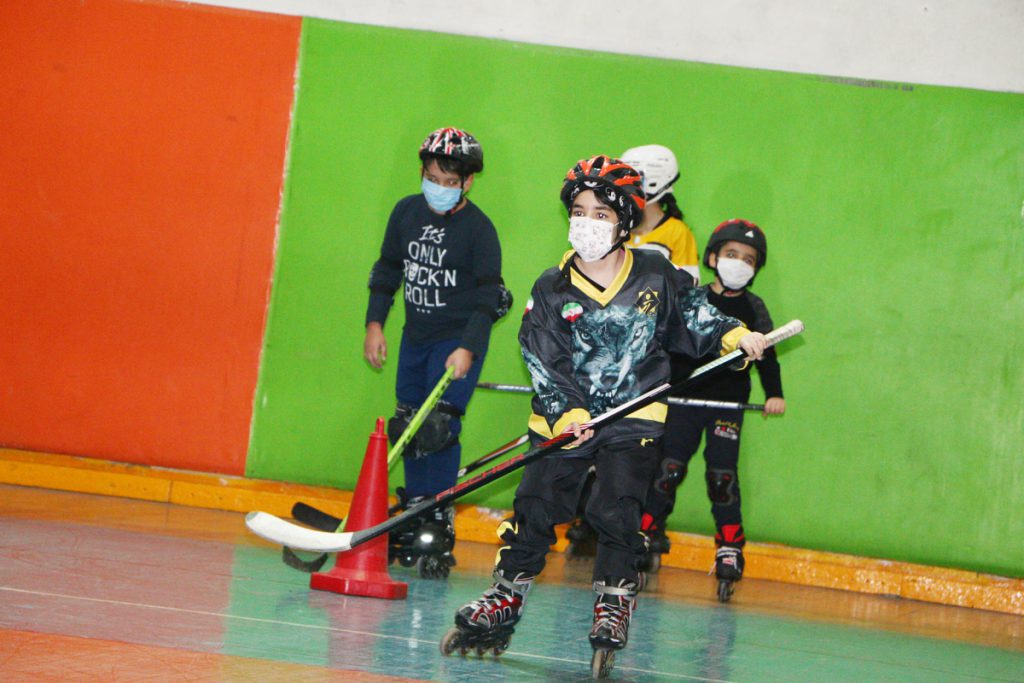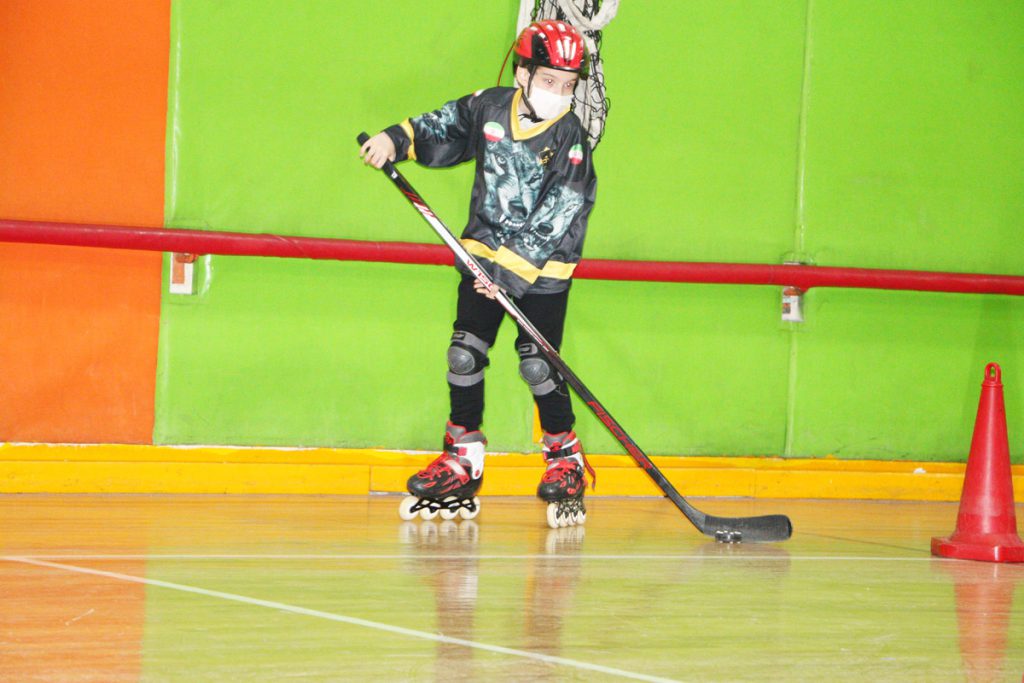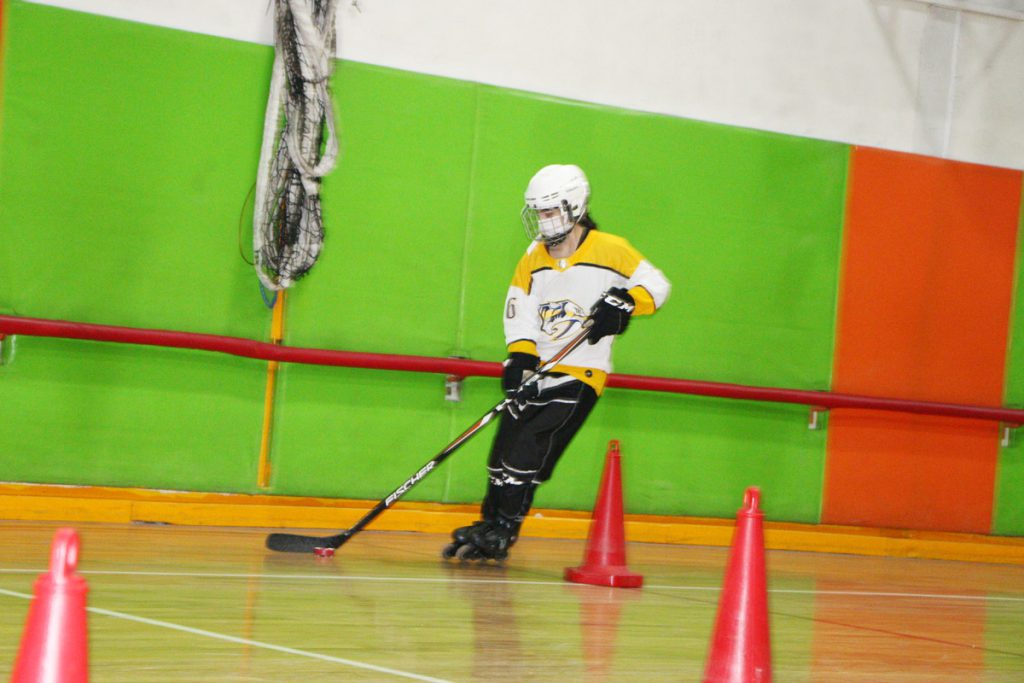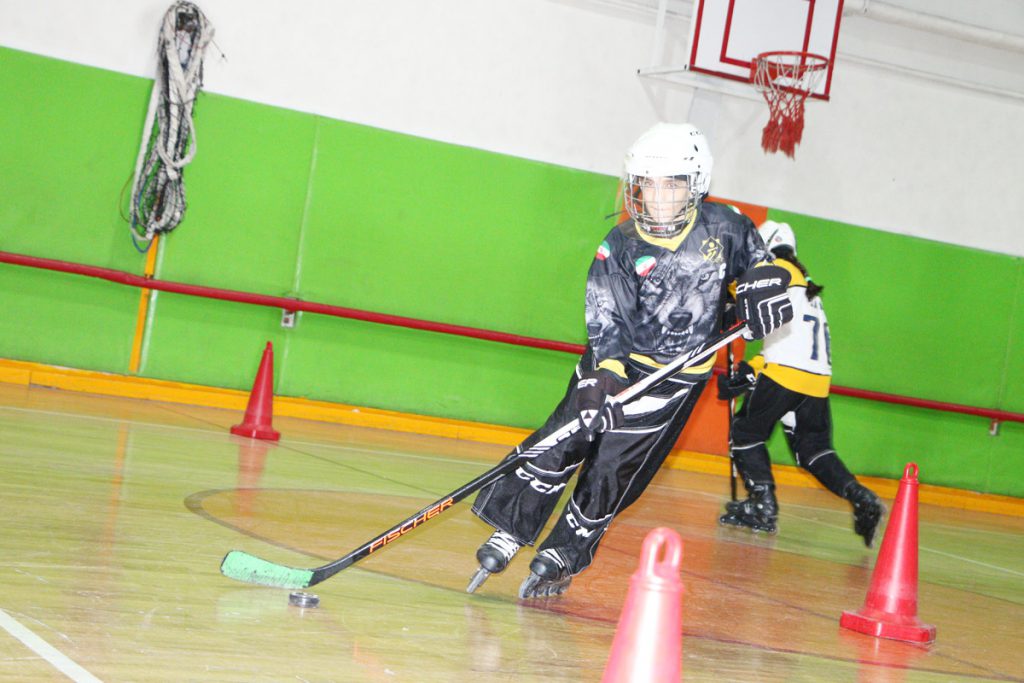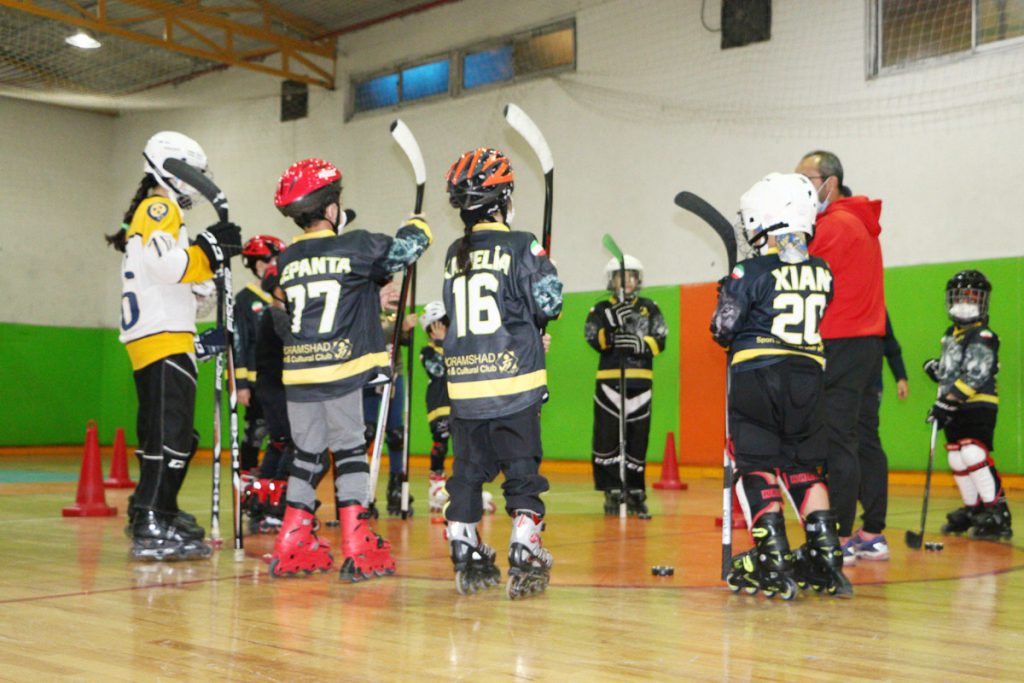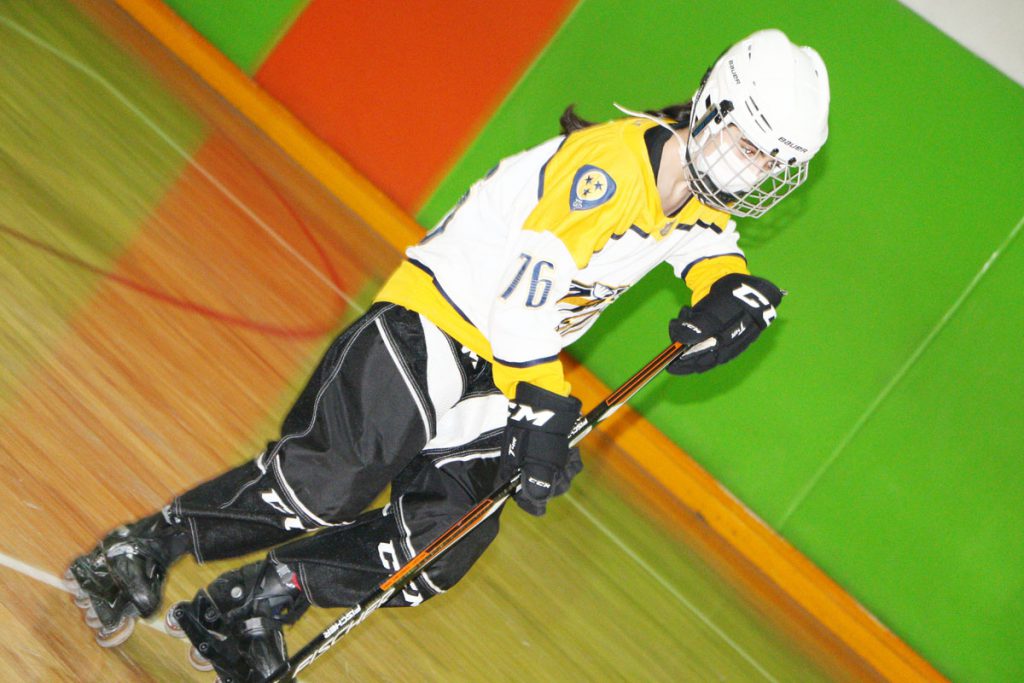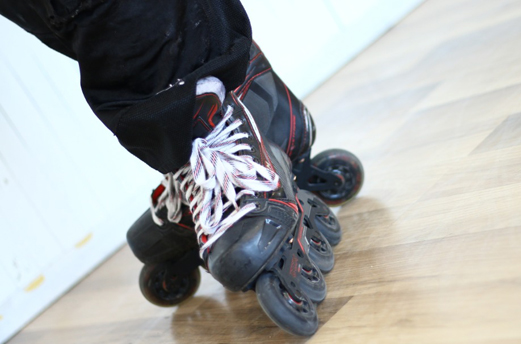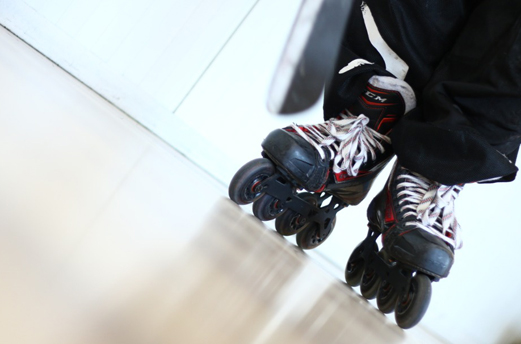Inline Hockey
Roller inline hockey (inline hockey) is known as completely a team sport in which there are five main players for each team on the rink. A goalkeeper and four players are a well-known combination for this exciting game. Speed, strength, accuracy and having a team spirit are the components of participating in this team sport. The excitement and high speed of this sport attracts every spectator to watch hockey matches. If you also have components for entering the hockey team, do not hesitate to reach a suitable team to participate in professional competitions.
Of course, every field has its own preparations, and special efforts must be made to achieve the necessary conditions to participate in professional teams and leagues. But participating in the entrance test of a skating academy and knowing the opinion of an informed person is worth considering. Either way, it will be a win-win situation: You will either become a member of the Roller inline hockey team, which is great, or you will be informed about the conditions of being on a professional team, which will bring your position closer to the status of the first state in the next few months.
But what are the prerequisites for attending a specialized class for roller inline hockey (inline hockey) training? Is it possible to participate in a specialized class with this much activity without any background or do we have to adapt to the entry conditions? What is the best age to attend roller inline hockey (inline hockey) classes? Is hockey for adults only or does it include children?
The result of the answer to all of the above questions is that you make the best decision for yourself and your child. Of course, in addition to all the expenses for a sport, you must also sacrifice time and provide the conditions for your child to be able to attend regular roller inline hockey (inline hockey) classes also, be 100% ready for great programs.
The best age to start roller inline hockey (inline hockey) is 5 or 6 years old. This means that before this age, it is not at all appropriate for a student to get involved in this sport. Of course, you can start roller inline hockey basics (inline hockey), which is the training of basic and complementary skating movements, at a younger age. But what are the basic steps required to attend roller inline hockey (inline hockey) basics classes?
Skating, crossover and backwards crossover are among the movements that are an integral part of roller inline hockey (inline hockey). Fast forward and backward starts require high mastery of the applicant for roller inline hockey (inline hockey). Therefore, one should not rush to enter the field of hockey, but it is better to spend enough time in basic and complementary movements to teach the student all the details in the training classes of the Skating Academy. In addition to attending training classes, it is necessary for students to practice individually to increase their mastery of skating. This is not something that can be achieved with 3 intensive courses, but there must be planning for individual training from the beginning and maintain up to the higher stages.
After passing the basic / advanced and professional courses and gaining complete mastery of the movements, and after the approval of the trainer, you can enter the roller inline hockey (inline hockey).
Roller inline hockey (inline hockey) is slightly different from other fields of skating, and the first obvious difference in this field is the use of complete safety equipment and its various equipment.
Equipment in this field include:
Hockey stick
Hockey ball (puck)
Hockey helmet
Hockey gloves
Hockey elbow pad
Hockey shin guard
Hockey chest pad
Shorts
Cup (for boys)
Special shirt
Special hockey pants
And finally, skate shoes for roller inline hockey (inline hockey), which we will introduce all pieces of equipment in full in the following.
The beginning of working in hockey will initially be with only a stick and a ball, and it is not necessary to provide all the equipment, exercises at the beginning of this course will focus more on getting familiar with hockey sticks, how to hold sticks properly and carry pucks with sticks and the period of time a person practices at this stage will vary depending on the age and skill of the individuals.
In general, it takes about 6 months for someone to do basic roller inline hockey (inline hockey) exercises and get closer to the hockey style. Skating style in this field is bending and in these 6 months, in addition to the relative mastery of the stick and the puck and also the increase of agility while skating, one gradually develops the style of hockey skating in their subconscious.
After passing the basic hockey course, the training will be somewhat more tactical and in groups so that one can practice and play as a team. The most famous of these exercises is Give and go, which consists of 4 people and a quick start, a sudden stop (slide), sending and receiving a correct pass, and a shot towards the goal are all seen in this exercise. In addition to these movements, the main goal is coordination between the people participating in this exercise.
Most of the exercises in this course are a combination of several people and several movements, and the player will focus on more specialized exercises of static handling and the ways of attacking, defending, tactics and predicting the events of the game.
roller inline hockey (inline hockey) equipment:
As mentioned above, there is no need to provide all the equipment to start hockey, and with just a stick and a puck, you can start the sport and prepare other equipment within about a year, depending on your progress. In general, the more experience you have in this field and the more advanced your training, the more likely you are to be injured and the need to complete your equipment will become obvious.
Hockey stick and ball/puck
The hockey stick consists of two parts, a shaft and a blade. The amateur type of hockey stick is made of wood and is heavier than professional sticks. Professional models of hockey sticks are extremely light (about 400 grams) and they are made of composite, fiberglass and carbon to create more strength in addition to reducing weight. And also the blades have different and various curves that are selected according to meet a player’s position and the type of a player’s game.
As mentioned, there are different types of hockey sticks in terms of material and type of blade curve, but since you are a newcomer, you can start with a regular but standard stick and after progressing and determining the position of the game as the goalies, forwards and defensemen, you can get a higher quality stick with a suitable curve for the position in which you play.
The height of the stick should be between your lips and your nose when you are standing and wearing skate shoes and the end of the stick is on the ground. Of course, at younger ages and due to the rapid growth of people at this age, as well as the coach’s recognition, it goes a little beyond this standard and is measured higher.
Hockey ball (puck) also has a function similar to that of the ball in other sports the goal of the game is to pass the puck through the goal line.
Hockey Tape
It is a tape made of cloth that has a sticky side and by sticking it to the blade, it causes better control of the ball on different movements and also prevents the ball to slip off the blade.
Hockey Gloves
After gaining relative skill in working with the stick and the ball, gradually a little more pressure is put on the hands, so it will be necessary to use hockey gloves to prevent blisters on the hands.
In addition to the pressure exerted on the hands during training or play, there is a high probability of the opponent’s stick or the ball hitting the hands, and if you do not use hockey gloves, this can cause damage in this part. The inner lining of the gloves is usually soft and flexible, and the softer the inner lining, the better the player’s mobility. The back of the glove is also made of very thick and strong layers of foam and pads to prevent possible hand injuries.
Hockey Helmet
The hockey helmet consists of two parts, the main shell of the helmet and the visor. The hockey cap on the head should be exactly the size and shape of the head, because if it is tight, it puts pressure on the skull, and if it is loose, it takes the focus away from the player during the play. In addition, hockey hats for children vary in size and it is possible to enlarge or reduce it.
There are different types of visors or face protectors:
The wire cage completely covers the entire face (forehead to chin). This visor provides high security for the player and it is quite normal to breathe with it, but it decreases the visibility of the player.
The visor covers the upper half of the face. This visor gives player the most amount of visibility and breathing is also normal with it. However, with using this visor the jaw and teeth are left totally exposed and its security is less than the wire cage for the player.
The full face visor provides the same amount of protection as a wire cage from the forehead to the chin and, in addition to complete safety, also gives the player the most amount of visibility. The only downside of this type of visor is in the player’s breathing, which sometimes fogs up between the face and the visor.
Hockey elbow pad and shin guard
The elbow pad is used to protect the forearm and elbow and prevents any damage to this part by combining compressed foam, pad and compressed plastic. The elbow pad starts about four fingers above the elbow and continues under the forearm and near the hockey glove.
The shin guard also starts from the top of the knee and continues to the ankle and the back of the hockey skate edge, and has a similar combination to the elbow pad to protect the leg.
Both the shin guard and the elbow pad must be fully secured by their adhesive straps and must be the size and shape of the hands and leg so that they do not move and do not rotate during the activity.
Shorts and chest pad
Shorts are responsible for protecting the knees to the waist and chest pad is responsible for protecting the chest and spine, which are composed of compact foam and pads on it.
Cup
They are used to protect the entire male genitalia, either separately or sewn into shorts.
A special sweater (jersey) and hockey pants are worn on all the equipment.
It should be noted that in ice hockey, special shorts are used instead of pants, and special hockey socks are also used on the shin guard.
Hockey Skates shoes (inline hockey)
Hockey skates (inline hockey) have a very strong body to prevent any injury to the foot caused by the stick and ball. They are very light and the ankle is free to execute more maneuvering power to the player.
Hockey skates (inline hockey) are always in the form of a rocker. In a way that there’s a more heel raised to the ground and the front wheels are closer to the ground from the toe side.
This engineered slope is either applied through the shoe itself, that is the frame tilts and the size of the wheels are fixed, or it is applied through the wheels, that is the frame does not tilt and the size of the wheels makes the skates tilt.
Hockey Stick
Hockey Stick
As mentioned in previous articles on the roller inline hockey, this field has a variety of equipment, all of which are to maintain the safety of the player except the ball, stick and skate shoes. In this article, we are going to deal with roller inline hockey sticks a little better and more finely.
Hockey sticks look like the Latin letter ‘L’ and were traditionally made entirely of wood in the past, but in the last two decades there have been significant advances in the technology of the materials used to make hockey sticks. In making these sticks, more expensive materials such as aluminum, fiberglass, carbon fibers and other composite materials are used, which in addition to reducing the weight of the wood, has made it more flexible than the hockey sticks which are made of wood.
In general, hockey stick consists of two parts: shaft (hockey stick handle) and blade (hockey stick blade). Some of these sticks have interchangeable wood or composite blades, while the others are one-piece and their blade cannot be changed.
The hockey stick shaft is relatively hard and stiff, but to improve the performance of the stick during powerful kicks and shots, it has a resilient state when performing these types of kicks with a spring-like mode. In addition to resisting breaking, it also doubles the power of the hockey ball and send a professional shot towards the goal.
As mentioned, hockey sticks are made of carbon fiber, fiberglass, wood or aluminum. Read on to find out exactly the advantages of each and make the best decision to buy a hockey stick. Your job prospects depend on the decisions you make when you start.
Carbon fiber
Carbon fiber is the most common wooden material in professional skate hockey players’ selection. Carbon fiber sticks initially entered the market as shafts alone, but nowadays, most hockey sticks are “one piece” sticks (shafts and blades). The first one-piece stick made of carbon fiber composite was introduced in 1992 by a Swiss company, which was a significant change in the hockey wood industry. Carbon sticks are one of the most popular sticks among hockey players due to their light weight and good flexibility and elasticity.
Fiberglass
Fiberglass was the first composite stick material, initially used with wood. Hockey sticks made solely from fiberglass but today, fiberglass is most commonly used as a composite with other materials, such as wood or carbon fiber.
Wood
Wooden hockey sticks are usually constructed by laminating multiple types of wood into a high quality plywood, then coating the stick and blade with thin plastic or fiberglass. Some manufacturers use fiberglass as a laminate between wood layers. However, this type of hockey stick is not the choice of any hockey player.
The main advantage of wooden sticks today is their low cost. People who for some reason have to practice outside the rink and on asphalt are the main fans of this type of stick. The most important disadvantage that wooden sticks suffer from is their heavy weight as well as the gradual change in their flexibility.
Aluminum sticks were the first non-wood sticks to appear that most often consist of a shaft made of an aluminum alloy and a wooden blade or composite blade, which is held in the shaft by glue and the compression of the shaft itself. There was a brief period in the 1990s when the majority of players welcomed these type of sticks, but today with the arrival of sticks with better technology, aluminum stick suddenly lost its fans.
The main advantage aluminum sticks enjoy is their unparalleled durability. It is fairly rare and nearly impossible for an aluminum stick to be broken or damaged, even at the professional level, and since the blades can be easily replaced, a shaft will typically last for a relatively long period of time. However, aluminum shafts, like other sticks, were not as elastic as other sticks.
The blade used to make contact with the hockey ball is typically 25 to 40 cm long and it is positioned at roughly a 135° angle from the axis of the shaft. The blade is slightly curved to have better performance when sending and receiving passes and also when shooting. It should be noted that the amount of this curvature varies according to the duty of the players and their position.
The goaltender has a slightly modified stick than the other players. The lower part of the stick is wider, the angle is smaller. These sticks also are made of the same composite technology as used in regular sticks of the players.
Composite sticks, despite their higher cost, is now commonplace in almost all competitive levels of this sport, including youth hockey.
Many professionals use composite sticks technology instead of wooden sticks, which in addition to the advantages mentioned, better control of the hockey ball, as well as much more accurate shots and passes are of features of non-wood sticks. Also, with these sticks, harder shots can be created with more pressure.
Some of the most expensive and professional hockey sticks include the following:
Bauer Vapor 1X, Bauer Supreme 1S, Bauer Nexus 1N, CCM Ribcor Trigger PMT2, CCM RBZ FT1, CCM Super Tacks 2.0, Easton Stealth CX, Easton Synergy GX, Warrior Covert QRL, Warrior Alpha QX, Warrior Dynasty HD1
Inline hockey sticks weigh between 390 and 470 grams.
Stick dimensions can vary widely, as they are usually built and adjusted to suit a particular player’s height and preference. But they are approximately 150–200 cm long and as mentioned earlier, to precisely adjust its height, the end of the stick should reach just below or above the chin when the player is standing with skate shoes and holding the stick vertically on the ground. Of course, this size will be a little longer in young players who are growing up.
In addition, defensive players tend to use longer sticks due to having more control over the opposing team’s attackers and also to apply more pressure to neutralize the players’ attacks.
Hockey Stick Blade
Hockey Stick Blade
As mentioned, a hockey stick is comprised of two parts, the shaft and the blade. In the blade part, we will see various shapes of curves.
There are three primary variables in blade design: curve, face angle, and toe.
The shape and the amount the hockey stick blade curves is different or it is more visible at the beginning of the blade (toe) or at the end of the hockey stick blade (heel).
Toe Curve Blade:
They are referring to a stick blade with greater amount of curving at the end (toe) of the blade. This is typically a forward’s preferred curve because it helps with more accurate shots.
Heel Curve Blade:
Heel curves generally help with slap shot accuracy and they are commonly preferred by defensemen.
Some of the top brands of composite sticks include the following:
Bauer
Easton
Reebok/CCM
Warrior
Hockey puck
Hockey ball (puck)
You must have seen the hockey ball by now. If you are playing in this field then you have lived with it, otherwise you have seen it either in official competitions or on TV. But have you ever wondered what the original name of the hockey ball is or what its production process is like or how its design has changed at different times?
The hockey ball which is called hockey puck is a disk made of vulcanized rubber (The vulcanization process makes the rubber resistant and waterproof. During the vulcanization, the rubber is oxidized at a temperature of 110 ° C and sulfur is reduced to sulfide. The result is the production of rubber materials such as solid rubber for example puck) that serves the same functions in various games as a ball does in ball games that when crossing the opponent’s goal line it earns points. Balls were used in hockey until the late 19th century, and from 1870 flat and quadrangular (square) hockey balls were made of wood or rubber. One of the reasons the shape of the hockey ball was changed from spherical to flat was to prevent the ball from leaving the rink.
In 1880 the first flat circular puck was made in Montreal and used in official hockey competitions, and this form has been preserved to this day.
The origin of the word ‘puck’ is a bit obscure. The Oxford English Dictionary derives the word from the verb ‘To Puck’ used in the game to shoot or strike or put pressure on the ball, ‘Puc’ in Scottish or ‘Poc’ in Irish means to hit.
It is possible that immigrants from Halifax, Nova Scotia (one of Canada’s southern provinces on the southeast coast of the country), many of whom were Irish and known in Canada as hockey players, introduced the word to Canada and over time, the word ‘puck’ has become ingrained in all hockey players.
The pucks used in inline hockey are very similar to the ones used in ice hockey in terms of function and appearance, but in terms of design and engineering, there are also differences, the first difference is in weight of these two pucks, the pucks used in ice hockey are much heavier than the ones used in inline hockey.
The second difference is in the appearance of the two, ice hockey pucks are flat and solid, while inline hockey pucks have semicircular ribs protruding from both sides so that beginners at first glance confuse these appendages with rounds balls. These ribs on both side of the puck limit contact with the surface, allowing better sliding motion and less friction causing the movement of the puck to be easier and more principled.
Inline hockey pucks come in a variety of colors, usually red, orange, yellow and green.
But it is the coach who decides which hockey puck is best for practicing and learning the movements. There are a variety of exercises in roller inline hockey, some of which are in the form of teams and groups and some are held individually. Using the right puck during practice will increase the player’s mastery for sensitive situations and will involve all aspects of a person’s ability.
Hockey Helmet
Hockey Helmet
Due to the importance of head and face safety, perhaps the most important safety equipment for skate hockey can be called a hockey helmet.
A hockey helmet is worn by players of ice hockey and inline hockey to help protect the head and skull from potential injury when hit by the puck, sticks, skates, boards, other players, or the ice and parquet.
The shell of a hockey helmet is generally made of a substance called vinyl nitrile that disperses force from the point of contact, while the liner may be made of either vinyl nitrile foam, expanded polypropylene foam, or other material to absorb the energy, to reduce the chances of concussion.
Designers and manufacturers of hockey helmets have designed this equipment according to accurate patterns and diagrams of human skull analysis, this helps to not to exert additional pressure on the skull and provide acceptable safety for players when an accident occurs.
Modern helmets’ size can be changed without the need for special tools. In older models, this was done by loosening and tightening the two screws on either side of the helmet, bringing the front and back of the helmet closer together or away.
Visor, Shield, and Cage
Visors, shields and cages are a means of protecting the face of hockey players attached to the front of a hockey helmet. Visors protect the upper part of the face and the shields cover the whole face for safety and protection of the face. Cages, like the shields, protect the whole face, but the difference is that cages are made of metal or mesh lattice.
With some irreparable and heartbreaking injuries, the most important of which was for Mr. Greg Neeld (December 7, 1973, during a game of ice hockey and a severe collision, he suffered severe facial injuries and had his left eye gouged and removed at the age of 17. He was also the first professional player in the history of hockey to use a face visor in official competitions after undergoing treatment and injury. Also, Mr. Bryan Berard suffered a gruesome eye injury at the beginning of his career in hockey. These irreparable injuries were a turning point in the importance of face protection in hockey and most hockey players and decision makers of the time forced the players of this sport to use face shields in official competitions, and in many leagues around the world, the use of visors or shields in competitions has become mandatory.
Visors and shields, made of a high impact-resistant plastic, offer better overall vision than the wire cages available, which can obscure vision in certain areas. The plastic face shield provides excellent straight ahead and peripheral vision, but does not provide as good air flow as a cage and this lack of good air flow fogs up between the face and the visor. Cages consist of a metal or composite mesh that covers the entire face, the bars, or cage, are spaced far enough apart to allow seeing through to the action but are close enough to stop pucks and sticks from getting through to injure the face.
The hockey visor was first invented by William Clay. He was a professional Vanderhoof Bears hockey player and he lost vision in his left eye to a high stick by his opponent while playing which made him to be hospitalized in Vancouver’s hospital for a month. This incident caused William concern, and finally in 1964 he made the first clear face shield. Of course, his invention was not immediately used in official competitions.
Nowadays, the use of face shields has become necessary among hockey players, and in the meantime, their power of choice has increased.
That is why there is a lot of emphasis on the preparation of hockey equipment and it is taken seriously by the coaches. Because anyone who has experienced the speed and excitement of playing hockey knows that it is very dangerous to participate in this sport without safety equipment.
Hockey Gloves
Hockey Gloves
Hockey gloves are protective equipment used to protect the hands of players and goalkeepers from any injuries, bruises and wounds.
There are three styles of gloves worn by hockey players. Hockey players wear similar gloves on each hand, while goaltenders wear gloves of different types on each hand.
Hockey gloves will generally fall into two types of categories, the first being the traditional four-roll style. These types of gloves have more room on the inside, giving it a looser feel on the hand than the natural fit gloves. The other category of gloves are the natural or anatomical fit glove. These have a much tighter fit and stronger than the four-roll gloves, and are designed to become an extension of the players’ hand.
To prevent transferring hockey puck and sticks kicks on the back of the hand, gloves are tight on the hand, but ergonomically designed for better wrist mobility and range of motion.
Hockey gloves also range in sizes, and are generally available in three categories: junior, youth, and senior.
Junior size hockey gloves:
8 inches (20 cm), 9 inches (23 cm), 10 inches (25 cm)
Youth size hockey gloves:
11 inches (28 cm) and 12 in (30 cm)
Senior size hockey gloves:
13 inches (33 cm), 14 inches (36 cm) and 15 inches (38 cm)
As mentioned before, goaltenders wear a different type of glove on each hand. Their design is to aid the goaltender in performance of his duties. On the hand with which he carries his stick, the goaltender wears a blocker with a large pad across the back of the forearm, usually extending just beyond the wrist. According to global rules the blocking glove may be no wider than 8 inches (20 cm) and no longer than 15 inches (38 cm). The goaltender uses this pad against direct shots and place the pad on the path of hockey puck to deflect shots.
On the other hand, the goaltender wears a catching glove called a trapper, which is similar to a baseball glove. In addition to using it to catch shots, goaltenders can distribute caught pucks by tossing them from the catching glove. global rules limit the perimeter of the catching glove to 45 inches (110 cm) and the widest part of the glove may not exceed 18 inches (46 cm).
As you can see, every piece of inline hockey safety equipment has a world of information and design, and it is not as if they have been put to use without thinking. Years of experience and good and bad things have happened to provide us with high quality products that we can use for being healthy with high security.
But the point to be considered is the opinion of the coach who can do the best help to buy the equipment. The reason is the testing and experience for many years. By considering all the factors, you can have the best choice and walk one step after another in the path of growth and development in the field of roller inline hockey.
Inline Hockey Skates
Inline Hockey Skates
As you know, in all specialized skating fields, there are tools and equipment for the same field which have special features and elements in each and in accordance with the needs of athletes in the same field. One of the fields of skating with so much equipment is the specialized field of inline hockey skating. This field has relatively much equipment that we have introduced you to in some previous articles, and in this article we will pay a little more attention to inline hockey skates, their features and companies.
Hockey is a safe sport, but at the same time it is considered as a contact sport, so the safety equipment used in it, protects from head to toe. Skate shoes protect the ankles to the toes. Therefore, in addition to technical features, this shoe must also have protective features to protect the foot against possible forces (being struck by a ball, stick, or colliding with another player).
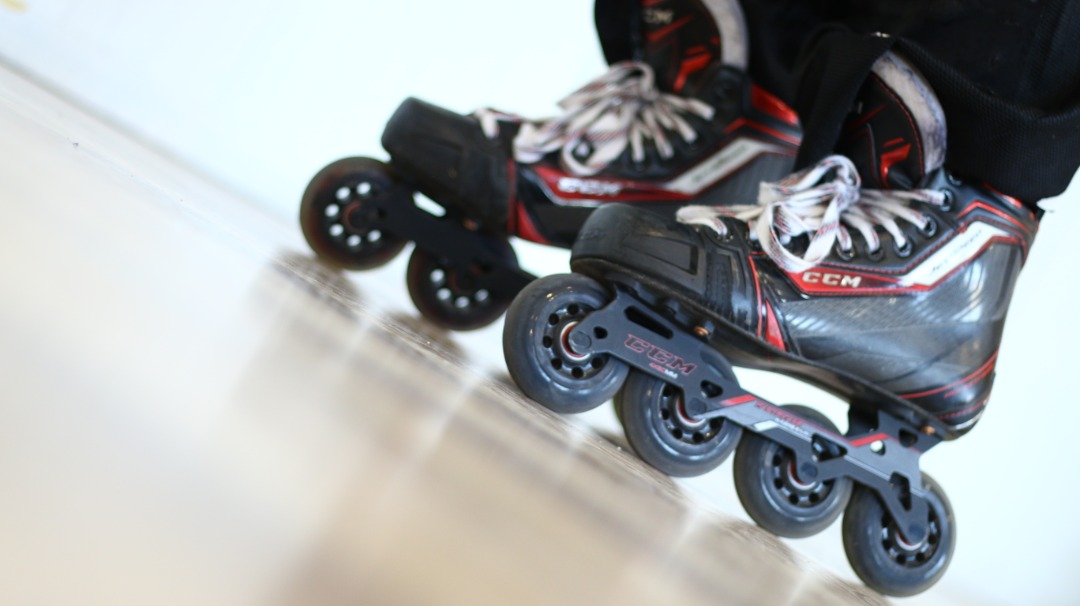

These skates are layered and have a very strong body. They are also designed in a way that for increasing the maneuverability of players and changing the direction of the foot, the ankle inside the shoes can move and bend freely.
Generally and informally, the higher the hardness of the inline hockey skates get and simultaneously the lighter they be, the better they will be considered.
Inline hockey skates are similar to ice hockey skates and the main difference is in their frame and wheels in a way that in ice hockey skates are with blade frames and in inline hockey, the frames are produced with wheels.
Inline hockey skates are marketed by manufacturers of hockey equipment with various brands, among which CCM and Bauer companies design and produce their skates for both ice hockey and inline hockey. Also, Mission and Tour companies are specialized in producing inline hockey skates.
Inline hockey skates have identical four-wheeled frames on both pairs of the shoe with diameters of 72, 76 or 80 mm or with a Hi-Lo frame structure in which the two front wheels are lower and the two rear wheels are higher. This innovation was patented in the United States on July 12, 1996 by John J. Wong and was first marketed by Mission Company. There is also a frame called Tri-Di that allows you to install three different wheel sizes on one frame. In this case, the sizes of the wheels will be from back to front, respectively, with sizes 80, 76, 76, and 72.
Therefore, in all three cases, the hockey skate shoes are in the form of a rocker forward and are always with a gentle slope of the skate in a way that the wheels are closer to the ground from the toe side than the heel side.
CCM Company
CCM was an initialism for Canada Cycle & Motor Co. Ltd. The company would eventually split into two separate entities both maintaining the CCM trademark, one maintaining bicycle manufacturing and the other, producing hockey equipment. The company was founded in 1899 after the time the bicycle market was going out of business and while large bicycle companies were merging to escape bankruptcy, and for many years was engaged in the production and marketing of bicycles to the Canadian market. By 1905, with saturation in the bicycle market, CCM began producing hockey skates using scrap steel that was leftover at the plant from the manufacture of bicycles. Nowadays, the scope of the company’s products in the hockey equipment industry is in the production of hockey sticks, skate shoes, hockey helmets, hockey elbow braces, hockey leg guards, hockey shoulder pads, hockey goaltenders’ hats, goalie neck guards and hockey clothes.
Bauer Company
In 1927, the Bauer family established the Bauer Skate company. Bauer was the first hockey company that produced hockey equipment and it began producing hockey skates. In the 1960s and ’70s, the company signed a contract with ice hockey superstar Bobby Hall to approve its hockey boots. In 1994, Bauer became a wholly owned subsidiary of Nike. In 2006, the company’s products were rebranded as Nike Bauer, and this was the first time Nike had ever used a partner brand name on a product. Eventually Nike sold the company to one of its investors and the company was once again known as Bauer on February 21, 2008.
On September 25, 2008, Bauer officially announced the purchase of rival Mission-Itech, its competitor and became a subsidiary of the company.
These days, Bauer designs and manufactures hockey helmets, hockey sticks, gloves, hockey pants, goaltending equipment, chest pads and shorts, and shoulder pads.
Mission Company
Mission is a company that produces inline hockey and formerly ice hockey equipment. In 2004, the company merged with Itech becoming Mission-Itech, and as mentioned, on September 25, 2008, Bauer Company had purchased Mission-Itech. Since 2009, their ice hockey products have been marketed under the name Bauer, and only inline skates branded Mission, have entered the market.

